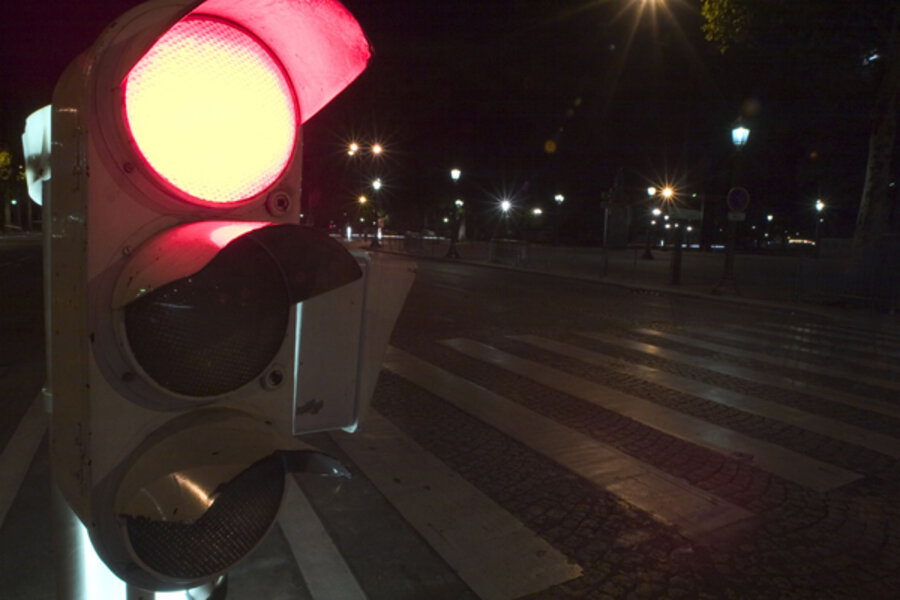Illinois considers bill banning red-light cameras
| Chicago
Red-light cameras meant to fine speeders through dangerous interjections are instead catching flack from activists and lawmakers who say they are unnecessary and actually create more accidents than they are meant to prevent.
A movement is under way in cities as large as Chicago and as small as Chillicothe, Ohio, to ban the cameras. Voters in communities as diverse as Heath, Ohio, and College Station, Texas, have rejected the cameras through referendums.
This week, the Illinois State Senate created a special subcommittee to study a bill that would eliminate the cameras throughout the state. State Sen. Dan Duffy (R) says the bill could move to the Senate floor in two weeks. If it passes, it would make Illinois the fifth state to ban the cameras.
[Editor's note: The original version of this story incorrectly listed the number of states who have banned red-light cameras.]
“Illinois citizens are very upset with the intrusive nature of the red-light cameras and are contacting their representatives in Springfield,” Senator Duffy said in a statement. “The voters understand that the cameras raise lots of revenue for the government to spend, while improvement in safety is questionable.”
In fact, detractors argue that the red-light cameras are causing an increase in rear-end collisions, as drivers hit the brakes in an effort to avoid a pricey ticket.
But some safety organizations, such as the Active Transportation Alliance, which is a nonprofit working to improve street safety for bicyclists and pedestrians, favor the cameras. The organization also says that money from the cameras can be redirected toward programs that improve street design or promote driver education.
“We hear what people are concerned about, and they’re not wrong.… We just don’t think the legislation being proposed is productive. Those issues can be fixed without banning the cameras,” says Margo O’Hara, a spokeswoman for the Alliance.
While cities say the cameras prevent accidents, they also happen to generate much-needed revenue, as each ticket costs drivers $100. The 270 cameras in Chicago brought in $58.9 million in 2009 alone. And motorists have little legal recourse. Among the limited ways to avoid paying are: If you were part of a funeral procession or can prove your car had been stolen at the time the ticket was issued.
Scott Tucker says the cost is a “nuisance.” “I’m tired of politicians creating tax after tax and repeatedly coming after our quality of life,” he says. Mr. Tucker, a business owner on the city’s North Side, is a Republican candidate for the 11th District state House seat.
Like many of the cameras’ detractors, Tucker charges that, in a bid to increase revenue, Chicago’s yellow lights were reduced to 2.5 seconds from the three seconds that is the federally required minimum. The city of Chicago denies that any change in timing has taken place.
“So we’ve made intersections less safe and not more safe. [The cameras] are not about safety, but really about revenue,” he says.
Data fluctuates depending on which side you support. The Insurance Institute For Highway Safety says cameras reduced red-light-running violations by 40 percent in communities such as Fairfax, Va., and Oxnard, Calif.
However, data like that represent “a built-in conflict of interest,” says Barnet Fagel, Illinois safety advocate and traffic researcher for the National Motorists Association. That’s because the cameras benefit the insurance industry, allowing them to raise rates in states where violations accrue.
Mr. Fagel supports independent research, such as a recent Chicago Tribune series, that showed that collisions were either increasing or holding steady at 60 percent of the 47 city intersections equipped with the cameras in 2006 and 2007.
The cameras, Fagel says, “are holding the driver up to a scientific level of accuracy that was never intended by any drivers’ test.” He charges that by shortening the yellow light time by half a second, more rear-end crashes are inevitable.
“That may not seem like enough [to make a difference], but when you’re moving a 40,000 pound truck behind 20,000-pound car, it becomes very, very critical,” he says.





